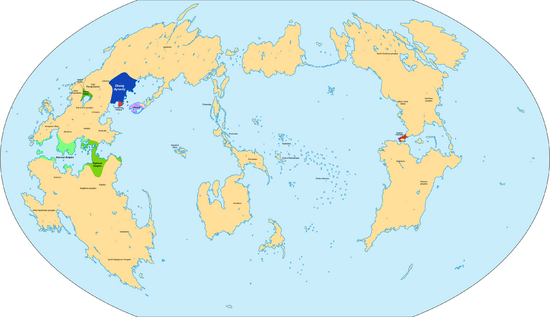1st millennium BCE
This article is a work in progress. Any information here may not be final as changes are often made to make way for improvements or expansion of lore-wise information about Gentu. Please comment on this article's talk page to share your input, comments and questions. Note: To contribute to this article, contact User:Philimania. |
| Millennia: | |
|---|---|
| Centuries: |
The 1st millennium BCE, also known as the last millennium BCE, was the period of time lasting from the years 1000 BCE to year 0. It encompasses the Iron Age and saw the transition of the Ancient Era to the Antiquity Era.
Gentu's population roughly doubled over the course of the millennium, from about 72 million to about 200–230 million.
Gentu in the 1st millennium BCE
Overview
In the Hesterath lowlands, the Cheng, Qiu, Xin would rise and fall and by the end of the millennium the Zhang dynasty would rise to take their place in its dynastic cycle. Around the early 3rd century BCE, the Hayosun Culture appeared on the Eyoseoul Peninsula.
In western Hesterath including the Kharankhui Highlands, The Enasan city-states in Plevapotamia were united into a single states named Iserlon under the rule of King Adamen I in 800 BCE. Around the same time would come the Endus, the oldest known sacred texts for the Plecan religion. In 369 BCE, Iserlon after being divided after the death of the king without an heir, collapsed and fell into war. At around 280 BCE, the Jukso people would wander into southern Plevapotamia and established the Juksan Empire there.
Meanwhile, around the same time in Flonesia, native Flonesian groups would begin to diverge from the original group such as the Auralian, Proto-Iolanan, XXX and XXX.
In Oranland, the Kingdom of Pylos would break away from the Calidum Empire resulting in the creation of the first recorded peace treaty to be made in 940 BCE. In 550 BCE, a meteor lands in the Zestoric Sea causing huge tidal waves to hit the coasts of Pylos and Calidum, ending the Ancient Era and nearly caused the collapse of both civilisations. Eventually, Calidum would fall to Pylos ending their dominance of the Zestoric Sea. from about the early 1st century BCE to 1 CE, Pylos would decline and eventually by assimilated into the Alarican Empire.
In central Naphtora, the Tomerian Culture emerged around the 1st century BCE around the XXX lake.
The Horaito civilisation appeared in Horapon around the mid 1st century BCE.
Around 290 BCE, the first state appeared in the Domicas in the central region. They emerged from the Yectun Culture as a union of 4 tribes, thus getting the name Quadran Federation.
Gentu's population doubled over the course of the millennium, from about an estimated 72 million to an estimated 200–230 million. Close to 90% of Gentu's population at the end of the first millennium BCE lived in Oranland, northern Naphtora, and Hesterath. The population of the Domicas was below 20 million, concentrated in Central Domica; that of Naphtora (not including northern Naphtora) was likely below 10 million. The population of Flonesia was likely less than one million people.
Timeline
Ancient Era
- 10th century BCE
- 1000 BCE: Iron Age begins.
- Hesterath lowlands: Yin Huiling overthrows the Quan; Cheng established.
- Flonesia: Native Flonesian groups begin to diverge from the original.
- northern Naphtora: 950 to 940 BCE: Calidum Civil War.
- Oranland: 940 BCE: First peace treaty; Pylos established; Remansete Period begins.
- 9th century BCE
- TBA
- 8th century BCE
- Plevapotamia: King Adamen I unites Enasan; founding of Iserlon.
- Plevapotamia: Plecanism founded; the Endus written.
- Oranland: 776 BCE: First recorded Endoric Games hosted by Remansete IV.
- 7th century BCE
- TBA
- 6th century BCE
- Hesterath lowlands: 560s BCE: Cheng-Quan Civil War begins.
- 550 BCE: Meteor strikes the Zestoric Sea; end of the Ancient Era and the Iron Age.
Antiquity Era
- 6th century BCE
- Hesterath lowlands: 548 BCE: Cheng-Quan Civil War ends.
- Hesterath lowlands: 548 to 522 BCE: Warring States Period.
- Hesterath lowlands: 522 BCE: Qiu dynasty established.
- North Domica: Creek city-states abandoned.
- 5th century BCE
- Kharankhui Highlands: Early 5th century: Jukso Culture appears.
- Oranland: 496 BCE: Neo-Pylos established; Remansete VII crowned king of Neo-Pylos; Pylosan Golden Age begins.
- Oranland: 490 BCE: Telescope invented.
- Central Domica: 480s BCE: Yectun people appears.
- Northern Naphtora: 450 to 364 BCE: War of the Twelve Lords.
- Plevapotamia: 421 BCE: Qargon II dies; Iren Agreement.
- 4th century BCE
- Eyoseoul Peninsula: Hayosun people appears.
- Plevapotamia: 369 BCE: Iserlonian Civil War begins.
- Northern Naphtora: 364 BCE: Pylos conquers Calidum; Pylosan Imperial Age begins.
- Late 4th century: Hesterlon Peninsula: Pylosan Empire colonises the peninsula.
- 3rd century BCE
- South Domica: Walivia Culture appears
- Central Domica: First Yectun settlement in the Domicas.
- Central Domica: 290 BCE: Quadran Federation established.
- Oranland: 283 to 214 BCE: Construction of Odius.
- Plevapotamia: 280s BCE: Jukso people wanders into Plevapotamia.
- Plevapotamia: 270s BCE: Juksan Empire established.
- Hesterath lowlands: 275-267 BCE: Nande War
- Oranland: Observatory invented.
- Hesterath lowlands: 221 BCE: Xin dynasty overthrows the Qiu.
- 2nd century BCE
- Hesterath lowlands: 199 to 173 BCE: Haidao Rebellion.
- Hesterath lowlands: 173 BCE: Zhang dynasty established.
- Eyoseoul Peninsula: 196 BCE: Yeongman Hwagug founded.
- 1st century BCE
- Central Naphtora: Tomerian Culture appears.
- Horapon: Horaito civilisation appears.
- Oranland: Ganoia recolonised.
- Oranland: Noemon establishes Alarico.
- Oranland: Hunyo 47 to Tebax 44 BCE: 1st Zestoric War.
- Horapon: 43 BCE: First settlement in Horapon.
- Horapon: 10 BCE: First fully fledged state.
- Oranland: 7 BCE to 1 CE: 2nd Zestoric War.
- Oranland: Year 0: Destruction of Odius.
Advancements
Inventions and discoveries
TBA
Literature
TBA
Archaeology
TBA
Centuries and decades








